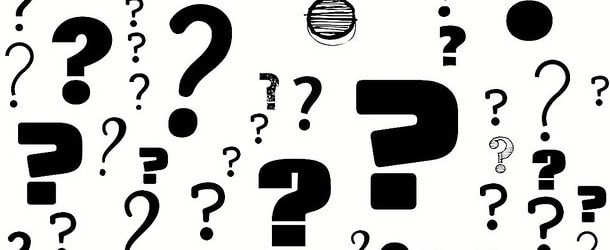
Applying for a mortgage can be stressful, what with all the money that’s on the line.
Oh, and the possibility that you could be denied entirely, perhaps while starting a family or attempting to relocate to a new state.
Making matters worse is the fact that all types of new words are thrown your way, which aside from being confusing, can make it difficult to negotiate a great rate on your home loan.
If you don’t know what the salesperson is talking about, how are you going to make your case for a better rate or lower fees?
My central message here at TTAM has always been empowerment through knowledge, with the reward being a better mortgage, whether it’s a lower interest rate, fewer closing costs, or simply the right product.
If you’re new to mortgage, you’ve probably got a lot of questions, and even if it’s not your first time, it never hurts to brush up on the basics.
Let’s discuss some of the more common mortgage lingo you might hear as you navigate the mortgage market, what the words mean, and how knowing them could save you some dough!
1. FICO
Let’s start with what’s arguably the most important mortgage-related term out there; your FICO score.
I say that because it can greatly impact what mortgage rate you ultimately receive, which can affect your wallet in a major way each and every month for many years to come.
If you’re applying for a mortgage, you’ve probably already heard of a FICO score because you have a credit card and/or a bank account, but you might not know just how much weight it carries.
Simply put, it can mean the difference between a rate of say 3% and 5% on a mortgage, depending on all the attributes of the loan.
So it’s nothing to take lightly, and something you should be well-versed on before you begin the process.
I’ve already written about mortgage credit score requirements extensively, but one key takeaway is that a credit score of 740 or higher will generally give you access to the lowest interest rates and most financing options.
2. LTV
Similarly crucial is your loan-to-value ratio, also known as LTV in industry terms. It too is a huge driver in determining your mortgage rate, with lower LTVs typically resulting in lower interest rates.
You can calculate your LTV by dividing the loan amount by the sales price or value of the property.
So if you put $60,000 down on a $300,000 home, the LTV would be 80%. It happens to be a key threshold to avoid mortgage insurance and secure lower rates.
In short, the lower your LTV, the lower your mortgage rate in most cases, as it means you’ve got more invested and the lender is less exposed.
3. DTI
When a lender qualifies you for a mortgage, they’ll do some calculations to determine affordability.
The major one is your debt-to-income ratio, or DTI, which is calculated by dividing your monthly liabilities (that show up on your credit report) by your monthly gross income.
If you spend $4,000 a month on housing and other costs like an auto loan/lease and credit cards, and make $10,000, your DTI would be 40%.
Generally, you want it below 43% to qualify for most mortgages, though there are exceptions. But again, lower is better here.
4. Appraisal
Mortgage lenders will often use require a home appraisal to determine the value of your property as it’s the collateral for the loan.
While appraisal waivers are becoming more and more possible these days, you’ll likely be on the hook for the cost of the appraisal when applying for a home loan.
Cost aside, it’s very important that the property comes back “at value” to ensure your loan can close without delay, or worse, require an increased down payment to make it work.
Additionally, you’ll probably just want to know what a third-party appraiser values your property at to determine its worth.
5. FHA
It stands for Federal Housing Administration, which bills itself as the largest mortgage insurer in the world, with a portfolio that exceeds $1.3 trillion at last glance.
They insure the many FHA loans borrowers take out to finance their home purchases. Their signature loan is the 3.5% down payment mortgage.
It is a government-backed loan, as opposed to the conventional loans backed by entities like Fannie Mae or Freddie Mac.
6. VA
The U.S. Department of Veteran Affairs provides a similar guarantee to lenders that issue mortgage loans to veterans and active service members.
This allows them to offer more favorable terms to those who protect our country.
The signature loan option is a zero down payment mortgage that also comes with a low interest rate, limited closing costs, and no mortgage insurance requirement.
7. USDA
While they’re perhaps better known for juicy steaks, the USDA also runs a pretty significant home loan program that provides 100% financing to home buyers.
The caveat is that the property must be located in a rural area in order to be eligible for financing – but many areas throughout the United States hold this distinction, even if not too far from major metropolitan areas.
8. GSE (Fannie and Freddie)
If the loan is a conventional one, meaning non-government, it’s probably backed by either Fannie Mae or Freddie Mac, which are the two government-sponsored enterprises (GSEs).
These two private, yet government-controlled companies (since the latest housing crisis), back or purchase the majority of home loans originated by lenders today.
They allow down payments as low as 3% with credit scores down to 620.
While the down payment requirement is slightly below that of the FHA, their credit score requirement is quite a bit higher.
9. PMI
It stands for private mortgage insurance, and applies to most conventional home loans with an LTV above 80%. It protects the lender, not you, from default, and can be quite costly.
Yet another reason to come in with a 20% down payment when obtaining a mortgage.
If you can avoid PMI, you might be able to significantly lower your monthly housing payment. Mortgage rates also happen to be lower at/below 80% LTV.
10. MIP
The mortgage insurance equivalent for FHA loans is known as MIP, and includes both an upfront premium (typically financed into the loan amount) and an annual premium, paid monthly for the life of the loan in most cases.
Sadly, it applies no matter what the LTV, hitting FHA borrowers twice regardless of down payment. This is one of the major downsides of an FHA loan.
11. PITI
Your monthly mortgage payment can be summed up by one neat acronym: PITI. Ironic pronunciation aside, it stands for principal, interest, taxes, and insurance.
It’s a more accurate representation of your housing payment, which is often advertised as just principal and interest (making it look at lot cheaper!).
In short, don’t forget to account for the property taxes and homeowners insurance, which can significantly increase your monthly outlay.
12. ARM
One of the more popular, yet highly-scrutinized loan types available, the adjustable-rate mortgage typically offers a lower interest rate to homeowners versus a fixed mortgage.
The downside is that it can adjust much higher once any initial fixed period comes to an end, though you often get a full five or seven years before that happens.
At the moment, ARMs aren’t offering much of a discount versus fixed-rate mortgages, so they’re best to be avoided for most folks.
13. FRM
The most popular home loan choice is a fixed-rate mortgage, also known as a FRM.
Two common examples include the 30-year fixed and 15-year fixed.
The interest rate does not change during the entire loan term, making it a safe choice for borrowers.
The negative here is that you pay for that peace of mind via a higher mortgage rate, all else being equal.
14. HELOC
Once you’ve already got a mortgage, you might want to tap into your home equity via a home equity line of credit, known as a HELOC.
It differs from a traditional second mortgage in that you get a line of credit that you can borrow from multiple times, similar to a credit card.
You can borrow as little or as much of that line as you want, pay it back, then borrow again, or just leave it open for a rainy day.
And perhaps more importantly, you can keep your low first mortgage rate untouched.
15. LO
Your LO, or loan officer, is your guide through the mortgage application process.
This is the person you’ll first make contact with, who will help you choose a loan type, negotiate pricing, and contact whenever anything comes up.
They are your eyes and your ears, and also your liaison to the mortgage underwriter, who decisions the loan, and the loan processor, who keeps everything moving behind the scenes (the unsung heroes).
16. Mortgage Broker
Similar to an independent insurance agent, mortgage brokers work with lenders and borrowers simultaneously to find you the lowest rate and/or best loan for your unique situation.
They aren’t tied to one specific company so they can shop on your behalf and ideally show you a range of what’s available with little legwork on your part.
It’s an easy way to comparison shop without having to speak to more than one company or individual.
17. APR
The annual percentage rate (APR) is the cost of your loan, factoring in the lender’s closing costs. You can’t simply compare loan options by looking at their interest rates.
Because closing costs can vary by thousands of dollars, they must be considered to determine which loan offer is the best deal.
However, APR still has its limitations because not all costs are included, and it assumes you’ll keep the loan for the full term, which many homeowners do not.
18. Points
A mortgage point is just another (unnecessarily fancy) way of saying 1% of the loan amount.
Unfortunately, these types of points will cost you because they are paid for by the borrower, assuming they apply to your specific loan.
They may take the form of discount points (to lower your interest rate) or represent the lender’s commission, known as a loan origination fee.
Your next question might be are mortgage points worth it?
19. Rate Lock
A quoted mortgage rate means basically nothing until it’s actually locked by the lender on your behalf.
Once it’s locked in, the rate won’t be subject to changes even if mortgage rates rise and fall as your loan application is processed and eventually funded.
Just be sure to close on time to avoid having to pay a lock extension fee, or worse, losing your lock!
20. Impounds
The mortgage payment isn’t the only thing you’ll have to worry about every month.
There’s also property taxes and homeowners insurance, which often must be paid monthly via an impound account unless you specifically waive them for a cost.
The lender collects a portion of these payments monthly, then releases the necessary funds once or twice a year on your behalf.
There’s nothing inherently wrong with impounds, they can even make budgeting easier, but some folks like having full control of their money.
21. Pre-Approval
If you’re shopping for a home to purchase, it’s pretty much a necessity to have a mortgage pre-approval in hand or the seller’s agent likely won’t even call your agent back.
Aside from being more or less mandatory, they’re also helpful to determine affordability and snuff out any potential fires early on.
A pre-approval is also a stronger version of a pre-qualification, which is often just a verbal starting point.
22. LE (Loan Estimate)
The loan estimate, or LE, replaced the long-utilized Good Faith Estimate, or GFE.
It is a summary of your proposed mortgage that includes the loan type, loan amount, interest rate, monthly payment, APR, and closing costs.
You can use it to compare offers from other lenders when shopping your rate. Take the time to read through the whole thing!
23. CD (Closing Disclosure)
The closing disclosure, or CD, replaced the HUD-1. It provides the final details of the loan, and must be delivered to the borrower at least 3 days before loan closing.
It can be compared to the LE to determine if anything changed from around the time of the application to loan closing. It’s a good time to review and ask questions if necessary.
If you want to know even more, check out my comprehensive mortgage glossary that includes just about every mortgage-related word you’d ever want to know.



